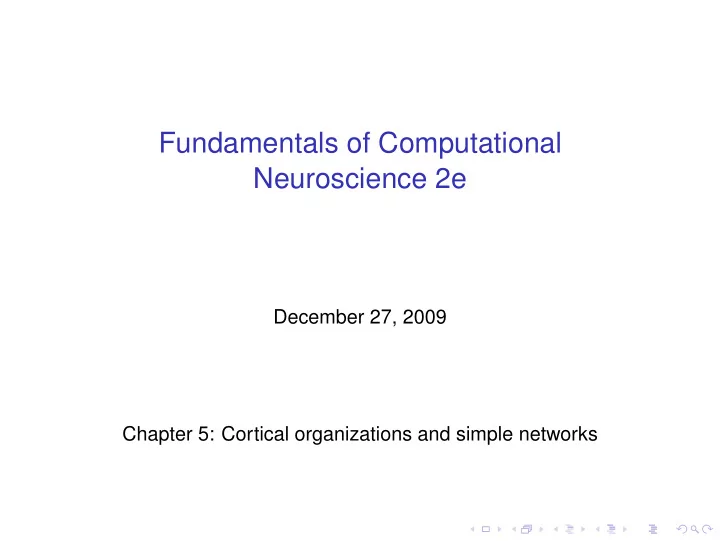

Fundamentals of Computational Neuroscience 2e December 27, 2009 Chapter 5: Cortical organizations and simple networks
Brain areas Dorsal 3 1 2 Parietal lobe Frontal lobe Occipital Caudal Rostral lobe Temporal lobe Cerebellum Brainstem Ventral
Hierarchical connectivity AITd TH FST 46 TF FEF AITv STPa CITv CITd STPp 7a PITv PITd MSTl VIP MSTd LIP VOT MT V4t DP V4 PO PIP V3A VP V3 V2 V1
Layered cortex A. Different staining techniques B. Variation in cortex I I I I Golgi Nissl Weigert II II II II { III I III III { III II IV { IV V IV IV III V V V VI VI { IV VI VI { V { VI
Layered cortical architecture I 2/3 II V2 III 4 IV 6 V VI 2/3 V1 4 6 LGN Subcortex Cortex Thalamus Subcortex
Cortical maps A. Ocular dominance columns B. Relation between ocular dominance and orientation columns left right eye left eye right eye eye D. Somatosensory map 1cm C. Topographic map of the visual field Hip Trunk Leg Neck Hand in primary visual cortex Shoulder m Elbow m r A r t a s Hand Foot i e r Little W r o Ring Toes F Middle Left visual field Index Genitals b m u Eye s h r T e Nose g n F i e c a F 5 Right V1 Upper lip 3 Lower lip 1 Teeth, gums, and jaw 2 T o n g u e 4 4 6 2 6 Fovea 5 abdominal 3 1
Neuronal chains A. Linear chain B. Diverging--converging chain -
Netlets A. Without inhibitory neurons B. With inhibitory neurons 1 1 Fraction of active neurons at t +1 Fraction of active neurons at t +1 Saturation Steady state Saturation Steady state 0.75 0.75 Θ =1 Θ =2 Θ =1 0.5 0.5 Θ =3 Θ =4 Θ = 2 Θ = 5 0.25 0.25 Θ =3 Θ =6 Θ = 4 Θ = 5 0 0 0 0.25 0.5 0.75 1 0 0.25 0.5 0.75 1 Fraction of active neurons at t Fraction of active neurons at t
Random networks with axonal delay A. Spike trains in random network C. Spike activation with axonal delay 1000 a 1 5 9 Neuron number d 800 s m 1 a 5ms b s m 500 9 c b d 8ms 5ms c 1 m e s 0 1 5 8 e 0 0 500 1000 Time [ms] Time [ms] B. Power spectrum in random network 1.5 9 10 1 8 a a Power b b 1 Power c c 0 20 40 60 80 100 d d Frequency (Hz) 0.5 e e 0 1 4 8 9 0 3 7 8 9 0 Time [ms] Time [ms] 0 20 40 60 80 100 Frequency [Hz] from Izhikevich 2003/2006
1 % Created by Eugene M. Izhikevich, February 25, 2003 2 % Excitatory neurons Inhibitory neurons 3 Ne=800; Ni=200; 4 re=rand(Ne,1); ri=rand(Ni,1); 5 a=[0.02*ones(Ne,1); 0.02+0.08*ri]; 6 b=[0.2*ones(Ne,1); 0.25-0.05*ri]; 7 c=[-65+15*re.ˆ2; -65*ones(Ni,1)]; 8 d=[8-6*re.ˆ2; 2*ones(Ni,1)]; 9 S=[0.5*rand(Ne+Ni,Ne),-rand(Ne+Ni,Ni)]; 10 11 v=-65*ones(Ne+Ni,1); % Initial values of v 12 u=b.*v; % Initial values of u 13 firings=[]; % spike timings 14 15 for t=1:1000 % simulation of 1000 ms 16 I=[5*randn(Ne,1);2*randn(Ni,1)]; % thalamic input 17 fired=find(v>=30); % indices of spikes 18 if ˜isempty(fired) 19 firings=[firings; t+0*fired, fired]; 20 v(fired)=c(fired); 21 u(fired)=u(fired)+d(fired); 22 I=I+sum(S(:,fired),2); 23 end; 24 v=v+0.5*(0.04*v.ˆ2+5*v+140-u+I); 25 v=v+0.5*(0.04*v.ˆ2+5*v+140-u+I); 26 u=u+a.*(b.*v-u); 27 end; 28 plot(firings(:,1),firings(:,2),’.’);
Further Readings Edward L. White (1989) Cortical circuits , Birkh¨ auser Moshe Abeles (1991) Corticonics: Neural circuits of the cerebral cortex , Cambridge University Press
Recommend
More recommend